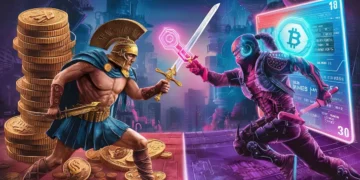High gas fees? Slow confirmation times? Rollups are designed to fix exactly that.
These scaling solutions process transactions off-chain and send the final results to Ethereum, improving speed and lowering costs. In this guide, you’ll learn what rollups are, how they work under the hood, and why they’re the foundation of Ethereum’s rollup-centric roadmap.
What Are Rollups in the Context of Blockchain?
A rollup is a type of layer-2 protocol that lives on top of a base blockchain (like Ethereum). It executes transactions off the main chain and then posts the transaction data or results back onto layer 1 for finalization. This way, it inherits Ethereum’s security while reducing load.
In simpler terms, a rollup “rolls up” hundreds of transactions and submits them as a single batched transaction on the main chain. This distributes the L1 gas fee across all users in the batch, drastically lowering transaction costs per user. By aggregating activity this way, rollups offload work from the main network while still letting the main network verify and secure the outcomes.
Why Rollups Matter for Scaling
Ethereum handles only about 15 transactions per second. That’s not enough. During busy periods, fees spike and users get priced out. This leads to serious network congestion.
Rollup technology solves this. It moves transaction execution off-chain and posts a summary back to Ethereum. So you get much higher transaction throughput and lower gas costs.
Instead of clogging the underlying blockchain, rollups compress hundreds of transactions into one. That one update gets verified on Layer 1. It’s efficient and secure—and it avoids bloating Ethereum’s limited block size, which caps how much data can fit into each block.
How Rollups Became Essential
Rollups emerged as scaling solutions in 2018–2019.
In October 2020, Ethereum introduced a rollup-centric roadmap. This made rollups a core part of its scaling plan.
By late 2023, rollups were processing twice as many transactions as the Ethereum Mainnet. In 2024, usage hit 2.4 billion transactions across major Layer 2s. Ethereum’s Dencun upgrade in March 2024 lowered data costs, making rollups faster and cheaper.
Today, rollups help Ethereum scale without compromising decentralization.
Read also: Blockchain Layers 101
How Rollups Work: Key Technical Concepts
At a basic level, rollups operate by shifting transaction work off the main chain and then “checking in” the results onto Layer 1. Here are the key technical concepts behind how rollups work.
Off-chain processing
Rollups don’t execute everything on Ethereum. Instead, they process transactions elsewhere. These off-chain transactions happen on specialized networks run by sequencers or validators. This reduces the load on Ethereum and speeds things up. It also cuts costs dramatically.
Transaction bundling
Once processed, rollups group many actions into a single transaction batch. This batch is sent to Ethereum as one update. Instead of hundreds of calls, Ethereum sees just one. Everyone shares the gas fee. This makes activity much cheaper per user.
Validation and compression (for ZK rollups)
Efficient transaction processing is the goal of ZK rollups. They generate a tiny cryptographic proof to confirm everything in the batch is valid. This proof replaces raw data and saves space. Ethereum checks the proof, not every transaction. It’s fast, secure, and compact.
Submission to the main blockchain
After validation, the rollup posts the batch to Ethereum. This is how rollup scaling solutions inherit security from Layer 1. The data (or its proof) goes into Ethereum’s ledger. This step anchors the rollup’s state to the main chain.
Verification and settlement
Once posted, the batch is verified. For ZK rollups, Ethereum checks the proof instantly. If valid, the update is final. For optimistic rollups, there’s a delay when others can challenge invalid batches. After this window, it’s finalized. This ensures settlement is secure and trustless.
Two main types of rollups
There are two core types of blockchain rollups. Both scale Ethereum, but they work differently.
Optimistic Rollups
Optimistic rollups assume every transaction is valid by default. No proof is posted upfront. Instead, the system includes a challenge window—usually 7 days—where anyone can dispute fraudulent transactions.
If someone catches fraud, they submit a fraud proof to Ethereum. This proof replays the transaction to show it broke the rules. If correct, the bad batch is rolled back. Honest actors are rewarded; bad actors are slashed.
You lose speed on withdrawals: it takes a week to exit to Ethereum unless you use a fast bridge.
But you get low fees and EVM-level support. That combo has helped Arbitrum and Optimism hit $18B+ in TVL and millions of daily transactions.
ZK rollups
Zero-knowledge rollups take a different route. They use math, not assumptions. Each batch includes a zero-knowledge proof that confirms every transaction followed the rules.
These validity proofs are small but powerful. Ethereum verifies the proof and finalizes the batch instantly—without any waiting. Users can withdraw funds immediately.
Unlike optimistic rollups, no one needs to monitor for fraud. If the math checks out, it’s valid. This makes ZK rollups more secure in theory.
Another huge perk is privacy. Transaction details can be kept hidden while still proving validity. Most current ZK rollups don’t use this yet, but it’s possible.
ZK rollups are harder to build, though, especially if you want full smart contract support. But it’s happening—zkSync and StarkNet are already live. They’re processing real DeFi and NFT activity, with hundreds of millions in TVL.

Key Differences
ZK rollups and optimistic rollups both aim to scale Ethereum, but they work differently.
ZK rollups validate everything upfront using cryptographic proofs, so it’s fast and final. Optimistic rollups operate on trust.
Withdrawals show this contrast. ZK rollups allow near-instant exits. Optimistic rollups make you wait around 7 days.
ZK rollups compress and prove each transaction, while optimistic rollups bundle them and rely on fraud checks only if challenged. Both process transactions efficiently and handle transactions off chain, reducing mainnet congestion.
Applications of Rollups
Rollup solutions are already powering everything from DeFi to gaming to social apps.
In DeFi, they make trading, lending, and yield farming cheaper and faster. Uniswap, Aave, and Curve all run on rollups to cut gas fees.
For payments, rollups unlock near-zero fees. Sending ETH or stablecoins costs a fraction of a cent. That makes tipping, remittances, and small transfers possible again.
In gaming, rollups keep in-game actions smooth and cheap. Platforms like Immutable X let users mint and trade NFTs without paying gas. It feels instant—because it almost is.
Social platforms are also getting the rollup treatment. Base (built on Optimism’s stack) helped apps like friend.tech go viral with fast, cheap interactions.
Even traditional finance is testing rollups. Visa demoed auto-payments using account abstraction on StarkNet. That’s how close we are to mainstream adoption.
Rollup Examples
Optimistic Rollups
These were first on the market. They’re EVM-friendly, cheaper to run, and now secure billions in value. Let’s look at some of the biggest names.
Arbitrum
Launched in 2021 by Offchain Labs, Arbitrum is the largest optimistic rollup today. It supports all Ethereum smart contracts out of the box.
DeFi loves it. Apps like GMX, Uniswap, and Aave thrive here. The network secures over $14.6 billion in assets and handles millions of transactions daily. It introduced its ARB token in 2023 and now runs under DAO governance.
Optimism
Optimism also launched in 2021 with a minimal-diff approach, meaning it stayed as close to Ethereum as possible.
It’s behind Coinbase’s Base rollup (built on the OP Stack) and introduced its OP token and the Optimism Collective to fund ecosystem growth. Optimism now secures around $3.7 billion and is a top choice for developers thanks to its simplicity and speed.
Boba Network
Originally a fork of Optimism, Boba added a twist—Hybrid Compute. This lets smart contracts tap into off-chain APIs, mixing Web2 with Web3.
It launched in 2021 and operates across Ethereum, Avalanche, and BNB Chain. While its TVL is modest (around $10M), its tech is unique and pushes the rollup model into new territory.
ZK Rollups
These use cryptographic ZK proofs to verify transactions. They finalize instantly and open the door to privacy, efficiency, and scalability.
zkSync
Built by Matter Labs, zkSync launched its first version in 2020 and followed up with zkSync Era (a full zkEVM) in 2023.
It supports general smart contracts and feels just like Ethereum, except faster and cheaper. It’s already securing over $600 million in TVL and is gaining traction fast in DeFi and NFTs.
StarkNet
Created by StarkWare, StarkNet is a general-purpose ZK rollup powered by STARKs (a type of ZK proof that’s post-quantum secure).
It launched in alpha in 2022 and supports apps built in Cairo, a custom language. StarkNet secures over $670 million and is used in DeFi, gaming, and identity protocols. Its tech also powers platforms like Immutable X and dYdX v3.
Polygon zkEVM
Released in 2023 by the Polygon team, zkEVM is a bytecode-compatible ZK rollup—meaning it can run Ethereum smart contracts with no changes.
Backed by the massive Polygon ecosystem, it aims to bring security and scale without the sidechain trade-offs. TVL is smaller for now (~$30M), but it’s growing and gaining developer support.
Loopring
One of the earliest ZK rollups, Loopring launched in 2020 with a focus on payments and decentralized trading.
It uses zkSNARKs to power fast, gasless swaps and NFT transfers. The Loopring wallet is built around it, offering secure, low-cost self-custody. It holds around $40 million in TVL and continues to serve as a model for app-specific rollups.
Blockchain Rollups vs. Other Scaling Solutions
Rollups are one way to scale Ethereum, but how do they compare to sidechains, state channels, plasma, and sharding?
Rollups offer a balanced approach: they scale effectively without compromising Ethereum’s core security. Other methods—like sidechains, channels, or Plasma—often trade off security or flexibility. That’s why rollups, validiums, and app-specific chains anchored to L1 are now central to Ethereum’s long-term scaling plan.
Rollups vs. Sidechains
Sidechains like Polygon PoS or xDai are separate blockchains bridged to Ethereum. They rely on their own validators, meaning funds can be at risk if those validators misbehave. In contrast, rollups inherit Ethereum’s security—all data and transactions are posted and verified on Layer 1.
Sidechains can be cheaper (they skip L1 gas costs), but they trade off security. That’s why rollups are preferred for high-value use cases.
Rollups vs. State Channels
State channels (e.g., Bitcoin’s Lightning Network) allow off-chain transactions between a fixed set of participants. They’re fast and cheap but limited in scope. Everyone must stay online, and they don’t support complex apps.
Rollups are broader: no channels to open, and anyone can use them like a normal blockchain. They support smart contracts and large user bases—ideal for Ethereum’s dApp ecosystem.
Rollups vs. Plasma
Plasma was an earlier L2 idea that inspired rollups. It used fraud proofs but didn’t post full data to Layer 1—only hashes. If operators vanished, users might lose access to funds due to data unavailability.
Rollups fix this by always posting critical data on-chain. That makes state recovery and withdrawals trustless. In practice, rollups have replaced Plasma for most use cases.
Rollups vs. Sharding
Sharding splits the Ethereum blockchain into smaller parts (shards) that process in parallel. Ethereum originally planned full execution sharding, but that proved too complex. Instead, Ethereum now prioritizes rollups for execution and sharding for data availability (Danksharding, via EIP-4844).
Rollups do the computing off-chain. Shards will give them more space to store data cheaply. Ethereum’s roadmap now treats rollups + sharding as a joint strategy to scale while preserving decentralization.

Security Considerations
As we already mentioned, rollups inherit security from Ethereum—but that doesn’t mean they’re risk-free.
Smart contracts are still the backbone. If there’s a bug in the rollup’s code, funds can be lost. These are real security vulnerabilities, and we’ve seen close calls.
Also, most rollups today rely on a central sequencer. If it censors users or goes offline, things can stall. Some allow fallback exits, but that’s not seamless for average users.
Validating transactions off-chain introduces complexity, too. ZK rollups use cryptographic proofs. Optimistic rollups rely on watchers to catch invalid transactions. If no one’s there to challenge it, bad data might slip through.
Still, rollups post all critical data on-chain. So, even if a sequencer vanishes, anyone can rebuild the blockchain network state using the on-chain records.
The bottom line: rollups are more secure than sidechains, but you still need to trust the code, the team, and the upgrade process.
The Regulatory Landscape for Layer 2 Solutions
Like much of the crypto space, Layer 2s live in a legal gray zone for now. Regulators haven’t written the rulebook for rollups yet, but it’s only a matter of time. Given the scrutiny around crypto tokens lately, token classification is a key concern. Tokens like ARB or OP, issued on rollups, could be treated as securities. That brings legal requirements for disclosures and compliance—even if the network is “just infrastructure.”
Rollup operators, like sequencers, may also come under pressure. If they’re centralized, authorities could treat them as service providers and demand censorship or user reporting.
Cross-chain asset transfers are another hot topic. Moving funds between Layer 1 and Layer 2 often resembles traditional bridging. That alone can trigger scrutiny under FATF rules and anti money laundering laws.
A rollup network is open by design. It doesn’t enforce KYC—but the apps built on it might. That’s why regulators are watching closely, especially as DeFi and NFTs grow in popularity. Looking ahead, regulation will likely focus more on dApps and on-ramps than on the protocols themselves.
Why Rollups Are a Big Deal
Scalability has limits at Layer 1. Thankfully, rollups extend what Ethereum can do.
Rollups provide a way to process tons of data off-chain, while still anchoring to Ethereum for trust. This lets us maintain decentralization while speeding things up. Also as a result, you get lower transaction costs. A single transaction on Ethereum costs around $5. On a rollup, it’s $0.02 or less. That’s a game-changer!
And it changes what’s possible. Suddenly, decentralized applications aren’t limited by gas fees. Games, social apps, NFT markets—things that just don’t work when every click costs dollars. And it’s not just new dApps. Rollups support existing smart contracts too. You can deploy them almost as-is on Arbitrum, Optimism, or zkSync.
How do blockchain rollups work so well? They move computation off-chain and post only what’s needed to Ethereum. It’s fast, scalable, and secure.
We’re already seeing massive adoption. Billions in value, millions of users. With real users and real value, rollups have moved way beyond theory. They’re shaping how people use crypto today.
Final Words
Ethereum’s long-term growth depends on effective scaling. Right now, rollups present one of the clearest paths forward. They cut costs, boost speed, and preserve Ethereum’s security.
With each step forward, rollup technology matures—improving how users interact with blockchain apps, whether through faster transactions or more seamless cross-chain activity.
Major rollup networks like Arbitrum, zkSync, Optimism, and StarkNet are already live. Developers are building actively, and adoption is gradually increasing.
As the technology becomes more integrated, users may not even notice whether they’re on Layer 1 or Layer 2 anymore. That’s a strong signal that the tools are working as intended.
FAQ
What’s the main reason to use rollups?
Rollups let you use blockchain technology without the high costs or delays of Layer 1. They offer faster transactions, lower fees, and a smoother user experience—while still relying on Ethereum for security.
How do rollups reduce gas fees so much?
They bundle many transactions into one, spreading the cost across users. This results in low transaction fees compared to the Ethereum Mainnet, where individual transaction fees can spike during congestion.
Is bridging to a rollup safe?
Yes, it is, as long as you’re using the official bridge. Funds are locked in a Layer 1 contract, and withdrawals follow strict security rules enforced by the rollup’s protocol.
Are rollups only useful for DeFi?
Not at all. While they’ve helped scale decentralized finance, rollups also support a wide range of blockchain applications, from games and NFTs to social platforms and identity tools.
What is the purpose of a rollup?
The purpose of a rollup is to scale Ethereum by reducing congestion on the main chain. It processes transactions off-chain and uses a rollup smart contract to post the results to Layer 1 securely.
Are rollups only for Ethereum?
Currently, rollups are implemented on the Ethereum blockchain, but the idea can be applied elsewhere. Any chain that supports verification mechanisms could, in theory, support rollups.
Is my money safe on a rollup?
Your funds are as secure as the rollup’s design and implementation. With data posted on-chain and transaction validity ensured by fraud or validity proofs, rollups aim to offer strong protections—though risks still exist, especially in early-stage platforms.
What are gas fees and how much can I save?
Gas fees are the cost of using blockchain networks like Ethereum. On rollups, you can often save over 90%, paying cents or fractions of a cent per transaction instead of dollars.
Disclaimer: Please note that the contents of this article are not financial or investing advice. The information provided in this article is the author’s opinion only and should not be considered as offering trading or investing recommendations. We do not make any warranties about the completeness, reliability and accuracy of this information. The cryptocurrency market suffers from high volatility and occasional arbitrary movements. Any investor, trader, or regular crypto users should research multiple viewpoints and be familiar with all local regulations before committing to an investment.
High gas fees? Slow confirmation times? Rollups are designed to fix exactly that.
These scaling solutions process transactions off-chain and send the final results to Ethereum, improving speed and lowering costs. In this guide, you’ll learn what rollups are, how they work under the hood, and why they’re the foundation of Ethereum’s rollup-centric roadmap.
What Are Rollups in the Context of Blockchain?
A rollup is a type of layer-2 protocol that lives on top of a base blockchain (like Ethereum). It executes transactions off the main chain and then posts the transaction data or results back onto layer 1 for finalization. This way, it inherits Ethereum’s security while reducing load.
In simpler terms, a rollup “rolls up” hundreds of transactions and submits them as a single batched transaction on the main chain. This distributes the L1 gas fee across all users in the batch, drastically lowering transaction costs per user. By aggregating activity this way, rollups offload work from the main network while still letting the main network verify and secure the outcomes.
Why Rollups Matter for Scaling
Ethereum handles only about 15 transactions per second. That’s not enough. During busy periods, fees spike and users get priced out. This leads to serious network congestion.
Rollup technology solves this. It moves transaction execution off-chain and posts a summary back to Ethereum. So you get much higher transaction throughput and lower gas costs.
Instead of clogging the underlying blockchain, rollups compress hundreds of transactions into one. That one update gets verified on Layer 1. It’s efficient and secure—and it avoids bloating Ethereum’s limited block size, which caps how much data can fit into each block.
How Rollups Became Essential
Rollups emerged as scaling solutions in 2018–2019.
In October 2020, Ethereum introduced a rollup-centric roadmap. This made rollups a core part of its scaling plan.
By late 2023, rollups were processing twice as many transactions as the Ethereum Mainnet. In 2024, usage hit 2.4 billion transactions across major Layer 2s. Ethereum’s Dencun upgrade in March 2024 lowered data costs, making rollups faster and cheaper.
Today, rollups help Ethereum scale without compromising decentralization.
Read also: Blockchain Layers 101
How Rollups Work: Key Technical Concepts
At a basic level, rollups operate by shifting transaction work off the main chain and then “checking in” the results onto Layer 1. Here are the key technical concepts behind how rollups work.
Off-chain processing
Rollups don’t execute everything on Ethereum. Instead, they process transactions elsewhere. These off-chain transactions happen on specialized networks run by sequencers or validators. This reduces the load on Ethereum and speeds things up. It also cuts costs dramatically.
Transaction bundling
Once processed, rollups group many actions into a single transaction batch. This batch is sent to Ethereum as one update. Instead of hundreds of calls, Ethereum sees just one. Everyone shares the gas fee. This makes activity much cheaper per user.
Validation and compression (for ZK rollups)
Efficient transaction processing is the goal of ZK rollups. They generate a tiny cryptographic proof to confirm everything in the batch is valid. This proof replaces raw data and saves space. Ethereum checks the proof, not every transaction. It’s fast, secure, and compact.
Submission to the main blockchain
After validation, the rollup posts the batch to Ethereum. This is how rollup scaling solutions inherit security from Layer 1. The data (or its proof) goes into Ethereum’s ledger. This step anchors the rollup’s state to the main chain.
Verification and settlement
Once posted, the batch is verified. For ZK rollups, Ethereum checks the proof instantly. If valid, the update is final. For optimistic rollups, there’s a delay when others can challenge invalid batches. After this window, it’s finalized. This ensures settlement is secure and trustless.
Two main types of rollups
There are two core types of blockchain rollups. Both scale Ethereum, but they work differently.
Optimistic Rollups
Optimistic rollups assume every transaction is valid by default. No proof is posted upfront. Instead, the system includes a challenge window—usually 7 days—where anyone can dispute fraudulent transactions.
If someone catches fraud, they submit a fraud proof to Ethereum. This proof replays the transaction to show it broke the rules. If correct, the bad batch is rolled back. Honest actors are rewarded; bad actors are slashed.
You lose speed on withdrawals: it takes a week to exit to Ethereum unless you use a fast bridge.
But you get low fees and EVM-level support. That combo has helped Arbitrum and Optimism hit $18B+ in TVL and millions of daily transactions.
ZK rollups
Zero-knowledge rollups take a different route. They use math, not assumptions. Each batch includes a zero-knowledge proof that confirms every transaction followed the rules.
These validity proofs are small but powerful. Ethereum verifies the proof and finalizes the batch instantly—without any waiting. Users can withdraw funds immediately.
Unlike optimistic rollups, no one needs to monitor for fraud. If the math checks out, it’s valid. This makes ZK rollups more secure in theory.
Another huge perk is privacy. Transaction details can be kept hidden while still proving validity. Most current ZK rollups don’t use this yet, but it’s possible.
ZK rollups are harder to build, though, especially if you want full smart contract support. But it’s happening—zkSync and StarkNet are already live. They’re processing real DeFi and NFT activity, with hundreds of millions in TVL.

Key Differences
ZK rollups and optimistic rollups both aim to scale Ethereum, but they work differently.
ZK rollups validate everything upfront using cryptographic proofs, so it’s fast and final. Optimistic rollups operate on trust.
Withdrawals show this contrast. ZK rollups allow near-instant exits. Optimistic rollups make you wait around 7 days.
ZK rollups compress and prove each transaction, while optimistic rollups bundle them and rely on fraud checks only if challenged. Both process transactions efficiently and handle transactions off chain, reducing mainnet congestion.
Applications of Rollups
Rollup solutions are already powering everything from DeFi to gaming to social apps.
In DeFi, they make trading, lending, and yield farming cheaper and faster. Uniswap, Aave, and Curve all run on rollups to cut gas fees.
For payments, rollups unlock near-zero fees. Sending ETH or stablecoins costs a fraction of a cent. That makes tipping, remittances, and small transfers possible again.
In gaming, rollups keep in-game actions smooth and cheap. Platforms like Immutable X let users mint and trade NFTs without paying gas. It feels instant—because it almost is.
Social platforms are also getting the rollup treatment. Base (built on Optimism’s stack) helped apps like friend.tech go viral with fast, cheap interactions.
Even traditional finance is testing rollups. Visa demoed auto-payments using account abstraction on StarkNet. That’s how close we are to mainstream adoption.
Rollup Examples
Optimistic Rollups
These were first on the market. They’re EVM-friendly, cheaper to run, and now secure billions in value. Let’s look at some of the biggest names.
Arbitrum
Launched in 2021 by Offchain Labs, Arbitrum is the largest optimistic rollup today. It supports all Ethereum smart contracts out of the box.
DeFi loves it. Apps like GMX, Uniswap, and Aave thrive here. The network secures over $14.6 billion in assets and handles millions of transactions daily. It introduced its ARB token in 2023 and now runs under DAO governance.
Optimism
Optimism also launched in 2021 with a minimal-diff approach, meaning it stayed as close to Ethereum as possible.
It’s behind Coinbase’s Base rollup (built on the OP Stack) and introduced its OP token and the Optimism Collective to fund ecosystem growth. Optimism now secures around $3.7 billion and is a top choice for developers thanks to its simplicity and speed.
Boba Network
Originally a fork of Optimism, Boba added a twist—Hybrid Compute. This lets smart contracts tap into off-chain APIs, mixing Web2 with Web3.
It launched in 2021 and operates across Ethereum, Avalanche, and BNB Chain. While its TVL is modest (around $10M), its tech is unique and pushes the rollup model into new territory.
ZK Rollups
These use cryptographic ZK proofs to verify transactions. They finalize instantly and open the door to privacy, efficiency, and scalability.
zkSync
Built by Matter Labs, zkSync launched its first version in 2020 and followed up with zkSync Era (a full zkEVM) in 2023.
It supports general smart contracts and feels just like Ethereum, except faster and cheaper. It’s already securing over $600 million in TVL and is gaining traction fast in DeFi and NFTs.
StarkNet
Created by StarkWare, StarkNet is a general-purpose ZK rollup powered by STARKs (a type of ZK proof that’s post-quantum secure).
It launched in alpha in 2022 and supports apps built in Cairo, a custom language. StarkNet secures over $670 million and is used in DeFi, gaming, and identity protocols. Its tech also powers platforms like Immutable X and dYdX v3.
Polygon zkEVM
Released in 2023 by the Polygon team, zkEVM is a bytecode-compatible ZK rollup—meaning it can run Ethereum smart contracts with no changes.
Backed by the massive Polygon ecosystem, it aims to bring security and scale without the sidechain trade-offs. TVL is smaller for now (~$30M), but it’s growing and gaining developer support.
Loopring
One of the earliest ZK rollups, Loopring launched in 2020 with a focus on payments and decentralized trading.
It uses zkSNARKs to power fast, gasless swaps and NFT transfers. The Loopring wallet is built around it, offering secure, low-cost self-custody. It holds around $40 million in TVL and continues to serve as a model for app-specific rollups.
Blockchain Rollups vs. Other Scaling Solutions
Rollups are one way to scale Ethereum, but how do they compare to sidechains, state channels, plasma, and sharding?
Rollups offer a balanced approach: they scale effectively without compromising Ethereum’s core security. Other methods—like sidechains, channels, or Plasma—often trade off security or flexibility. That’s why rollups, validiums, and app-specific chains anchored to L1 are now central to Ethereum’s long-term scaling plan.
Rollups vs. Sidechains
Sidechains like Polygon PoS or xDai are separate blockchains bridged to Ethereum. They rely on their own validators, meaning funds can be at risk if those validators misbehave. In contrast, rollups inherit Ethereum’s security—all data and transactions are posted and verified on Layer 1.
Sidechains can be cheaper (they skip L1 gas costs), but they trade off security. That’s why rollups are preferred for high-value use cases.
Rollups vs. State Channels
State channels (e.g., Bitcoin’s Lightning Network) allow off-chain transactions between a fixed set of participants. They’re fast and cheap but limited in scope. Everyone must stay online, and they don’t support complex apps.
Rollups are broader: no channels to open, and anyone can use them like a normal blockchain. They support smart contracts and large user bases—ideal for Ethereum’s dApp ecosystem.
Rollups vs. Plasma
Plasma was an earlier L2 idea that inspired rollups. It used fraud proofs but didn’t post full data to Layer 1—only hashes. If operators vanished, users might lose access to funds due to data unavailability.
Rollups fix this by always posting critical data on-chain. That makes state recovery and withdrawals trustless. In practice, rollups have replaced Plasma for most use cases.
Rollups vs. Sharding
Sharding splits the Ethereum blockchain into smaller parts (shards) that process in parallel. Ethereum originally planned full execution sharding, but that proved too complex. Instead, Ethereum now prioritizes rollups for execution and sharding for data availability (Danksharding, via EIP-4844).
Rollups do the computing off-chain. Shards will give them more space to store data cheaply. Ethereum’s roadmap now treats rollups + sharding as a joint strategy to scale while preserving decentralization.

Security Considerations
As we already mentioned, rollups inherit security from Ethereum—but that doesn’t mean they’re risk-free.
Smart contracts are still the backbone. If there’s a bug in the rollup’s code, funds can be lost. These are real security vulnerabilities, and we’ve seen close calls.
Also, most rollups today rely on a central sequencer. If it censors users or goes offline, things can stall. Some allow fallback exits, but that’s not seamless for average users.
Validating transactions off-chain introduces complexity, too. ZK rollups use cryptographic proofs. Optimistic rollups rely on watchers to catch invalid transactions. If no one’s there to challenge it, bad data might slip through.
Still, rollups post all critical data on-chain. So, even if a sequencer vanishes, anyone can rebuild the blockchain network state using the on-chain records.
The bottom line: rollups are more secure than sidechains, but you still need to trust the code, the team, and the upgrade process.
The Regulatory Landscape for Layer 2 Solutions
Like much of the crypto space, Layer 2s live in a legal gray zone for now. Regulators haven’t written the rulebook for rollups yet, but it’s only a matter of time. Given the scrutiny around crypto tokens lately, token classification is a key concern. Tokens like ARB or OP, issued on rollups, could be treated as securities. That brings legal requirements for disclosures and compliance—even if the network is “just infrastructure.”
Rollup operators, like sequencers, may also come under pressure. If they’re centralized, authorities could treat them as service providers and demand censorship or user reporting.
Cross-chain asset transfers are another hot topic. Moving funds between Layer 1 and Layer 2 often resembles traditional bridging. That alone can trigger scrutiny under FATF rules and anti money laundering laws.
A rollup network is open by design. It doesn’t enforce KYC—but the apps built on it might. That’s why regulators are watching closely, especially as DeFi and NFTs grow in popularity. Looking ahead, regulation will likely focus more on dApps and on-ramps than on the protocols themselves.
Why Rollups Are a Big Deal
Scalability has limits at Layer 1. Thankfully, rollups extend what Ethereum can do.
Rollups provide a way to process tons of data off-chain, while still anchoring to Ethereum for trust. This lets us maintain decentralization while speeding things up. Also as a result, you get lower transaction costs. A single transaction on Ethereum costs around $5. On a rollup, it’s $0.02 or less. That’s a game-changer!
And it changes what’s possible. Suddenly, decentralized applications aren’t limited by gas fees. Games, social apps, NFT markets—things that just don’t work when every click costs dollars. And it’s not just new dApps. Rollups support existing smart contracts too. You can deploy them almost as-is on Arbitrum, Optimism, or zkSync.
How do blockchain rollups work so well? They move computation off-chain and post only what’s needed to Ethereum. It’s fast, scalable, and secure.
We’re already seeing massive adoption. Billions in value, millions of users. With real users and real value, rollups have moved way beyond theory. They’re shaping how people use crypto today.
Final Words
Ethereum’s long-term growth depends on effective scaling. Right now, rollups present one of the clearest paths forward. They cut costs, boost speed, and preserve Ethereum’s security.
With each step forward, rollup technology matures—improving how users interact with blockchain apps, whether through faster transactions or more seamless cross-chain activity.
Major rollup networks like Arbitrum, zkSync, Optimism, and StarkNet are already live. Developers are building actively, and adoption is gradually increasing.
As the technology becomes more integrated, users may not even notice whether they’re on Layer 1 or Layer 2 anymore. That’s a strong signal that the tools are working as intended.
FAQ
What’s the main reason to use rollups?
Rollups let you use blockchain technology without the high costs or delays of Layer 1. They offer faster transactions, lower fees, and a smoother user experience—while still relying on Ethereum for security.
How do rollups reduce gas fees so much?
They bundle many transactions into one, spreading the cost across users. This results in low transaction fees compared to the Ethereum Mainnet, where individual transaction fees can spike during congestion.
Is bridging to a rollup safe?
Yes, it is, as long as you’re using the official bridge. Funds are locked in a Layer 1 contract, and withdrawals follow strict security rules enforced by the rollup’s protocol.
Are rollups only useful for DeFi?
Not at all. While they’ve helped scale decentralized finance, rollups also support a wide range of blockchain applications, from games and NFTs to social platforms and identity tools.
What is the purpose of a rollup?
The purpose of a rollup is to scale Ethereum by reducing congestion on the main chain. It processes transactions off-chain and uses a rollup smart contract to post the results to Layer 1 securely.
Are rollups only for Ethereum?
Currently, rollups are implemented on the Ethereum blockchain, but the idea can be applied elsewhere. Any chain that supports verification mechanisms could, in theory, support rollups.
Is my money safe on a rollup?
Your funds are as secure as the rollup’s design and implementation. With data posted on-chain and transaction validity ensured by fraud or validity proofs, rollups aim to offer strong protections—though risks still exist, especially in early-stage platforms.
What are gas fees and how much can I save?
Gas fees are the cost of using blockchain networks like Ethereum. On rollups, you can often save over 90%, paying cents or fractions of a cent per transaction instead of dollars.
Disclaimer: Please note that the contents of this article are not financial or investing advice. The information provided in this article is the author’s opinion only and should not be considered as offering trading or investing recommendations. We do not make any warranties about the completeness, reliability and accuracy of this information. The cryptocurrency market suffers from high volatility and occasional arbitrary movements. Any investor, trader, or regular crypto users should research multiple viewpoints and be familiar with all local regulations before committing to an investment.





















































































The depth in this serving is exceptional.
I am in fact enchant‚e ‘ to coup d’oeil at this blog posts which consists of tons of profitable facts, thanks for providing such data.